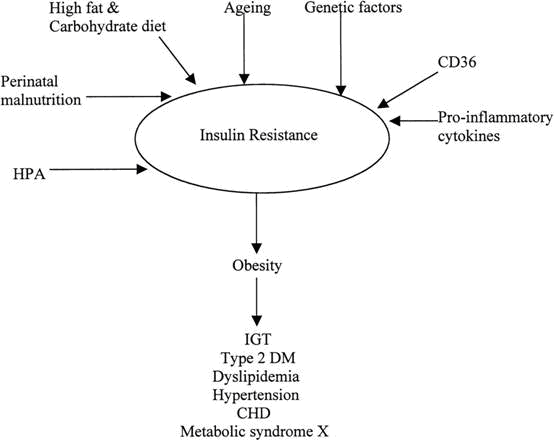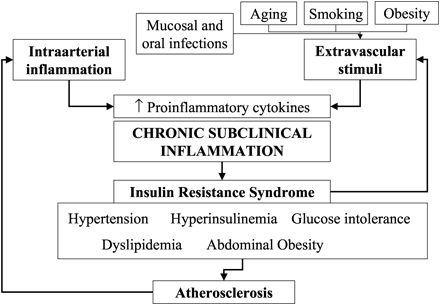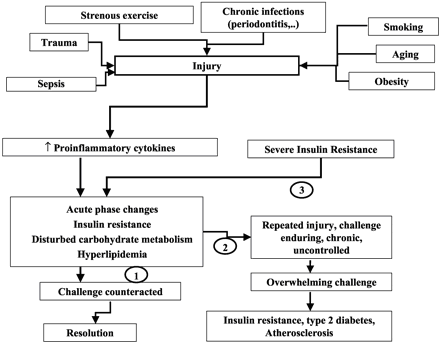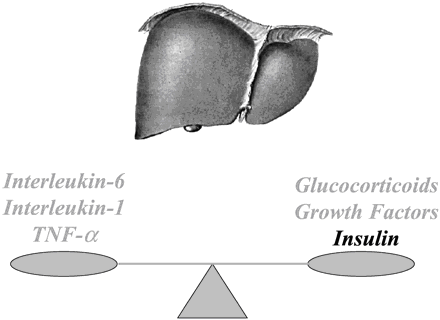The cardiometabolic risk syndrome is increasingly recognized as a chronic, low-level, inflammatory state. Elevated insulin levels due to decreased response to insulin may be the common factors for the development of each of the elements of the cardiometabolic risk syndrome:
- Hypertension
- Low HDL (good cholesterol)
- Elevated triglycerides
- Abdominal obesity
- Altered glucose tolerance
In recent years, atherosclerosis (hardening of the arteries) has come to be recognized as an inflammatory state and even several infectious organisms have been associated with causing heart disease. Inflammation with infection is commonly associated with redness and swelling in the skin from an injury, but we now know that the same process is taking place in the walls of the arteries and in the blood.
The below scheme shows factors that can influence the onset of cardiometaboic risk syndrome which previously was named the "metabolic syndrome X or the metabolic syndrome." (HPA stands for the "hypothalamo-pituitary-adrenal axis or system." CD36 refers to an integral membrane protein found on the surface of many cell types. It is also known as glycoprotein IV and glycoprotein IIIb.)

Cardiometabolic Risk Syndrome and inflammation
Obese patients with cardiometabolic risk syndrome (CRS) have significantly elevated concentrations of inflammatory markers including:
- oxidized low-density lipoprotein
- C-reactive protein
- tumor necrosis factor-
- IL-6
- Fibrinogen
- White Blood Cell Counts
- Ferritin
- Plamsinogen Activator Inhibitor
This suggests that the cardiometabolic risk syndrome heightens oxidative stress (See Related Articles below) and inflammatory burden in obese adults. Increased oxidative and inflammatory stress may contribute to the greater risk of coronary heart disease and cerebrovascular disease in obese adults with the cardiometabolic risk syndrome.
It is interesting to note that breast-fed infants have a lower incidence of obesity, insulin resistance, hypertension, diabetes mellitus, and coronary heart disease. This suggests that some constituent(s) of the breast milk may help them resist the development of these diseases. Breast milk is rich in long-chain polyunsaturated fatty acids (LCPUFAs). The absence of LCPUFAs in the diet of infants could be a major factor that influences the development of cardometabolic risk syndrome in adult life.
Pro-inflammatory Cytokines
Atherosclerosis and the cardiometabolic risk syndrome share similar causes mainly due to the actions of two major pro-inflammatory cytokines which are produced by fat cells: Tissue Necrosis Factor (TNF) alpha and Interleukin (IL) 6. Cytokines are substances which are produced by cells. Adipocytokines are substances produced principally by fat cells.
Possible pathways leading to chronic inflammation, resulting in atherosclerosis

The contribution of infection and inflammation to the development of the cardiometabolic risk syndrome is pictured here. The contribution of fat cells with their production of the pro-inflammatory cytokines is noted also. Also the bad effects of age, smoking and obesity are seen.
Proposed mechanisms leading to insulin resistance-related inflammation
Age, obesity, sedentary life style, and smoking also contribute to the inflammation which results from the cardiometabolic risk syndrome (CRS). Type 2 diabetes mellitus and the CRS lead to an ongoing acute-phase response, commonly seen in inflammation and infection. Step 3 of the illustration below shows that the acute phase response is caused by an increased IL-6 derived from fat cells.
The theory that the cardiometabolic syndrome (CRS) is an inflammatory condition is supported by findings in the CRS of increased blood concentrations of markers of the acute-phase response, including:
- C-reactive Protein
- serum amyloid-A
- -1 acid glycoprotein
- sialic acid
- cortisol
Increased IL-6 and the other markers of the acute-phase response may be counteracting hyperglycemia (elevated blood sugar) and insulin resistance as seen in Step 1 below. When pro-inflammation is enduring, chronic, or uncontrolled, and when a challenge becomes overwhelming, the failure to reach the desirable effect, i.e., decreased inflammation, results in worsening of hyperglycemia and insulin resistance (step 2). According to this theory, lack of exposure to injury or sepsis (infection) would result in pro-inflammation only when insulin resistance is severe (step 3).

The previous two illustrations demonstrate that obesity, smoking, age, elevated cholesterol, chronic infection, such as dental disease, and insulin resistance are contributing causes to the inflammation of both the cardiometabolic risk syndrome and the process of atherosclerosis. Already it is possible to suggest ways of decreasing inflammation: lose weight, exercise, stop smoking (SETMA’s LESS Initiative), good dental hygiene and strength the immune system.
Body Tissues which develop Insulin Resistance - Fat Cells and Adipocytokines
The main body tissues which are sensitive to the effects of insulin are fat tissue, muscle and the liver. When these tissues become resistant to the effects of insulin:
- The body develops a chronic, low-grade inflammatory state and
- Any process linked to chronic inflammation will decrease insulin action, and
- Insulin resistance will lead to worsening of inflammation in a vicious cycle.
Increased evidence suggests that generalized and abdominal obesity constitute low-grade inflammatory states. Adipose tissue (fat tissue) was originally thought to be a mere tissue of fat storage, but now we know that fat cell are active participants in energy balance. The term "adipocytokines" was recently coined to describe the fat-derived bioactive factors that affect the function of other tissues in our body.
As mention before the two principle adipocytokins are:
- Tumor Necrosis Factor alpha (TNF- ) seems to play a key role in regulating adipose tissue metabolism. In fat humans, TNF- is over active in the fat tissue, as compared with tissues from lean individuals.
- Interleukin 6 (IL-6) is secreted from fat tissue during non-inflammatory conditions in humans. Obesity increases secretion of IL-6, with its detrimental metabolic effects.
Insulin and Decreased inflammation
Insulin decreases IL-1- and IL-6-type cytokine stimulation. Thus, insulin resistance with its decreased insulin action, as found in type 2 diabetes and the cardiometabolic risk syndrome would not be able to block TNF- , IL-1, and IL-6 actions, leading to prolonged acute-phase reaction and a chronic, low-grade inflammation in the body. The acute-phase response changes are small in insulin resistance in comparison with those found in infection or trauma, but the potential damage is greater because of the chronicity of the changes.
Systemic inflammation, measured by increased serum acute-phase reactants such as C-Reactive Protein, has been recognized to occur in type 2 diabetes since at least 1989. Significantly higher serum concentrations of CRP, fibrinogen, 1-acid glycoprotein, amyloid A, sialic acid, and orosomucoid have been described in patients with type 2 diabetes mellitus. Elevated serum CRP concentrations have been demonstrated consistently in overweight and obese adults, even among young adults aged 17-39 yr.
In one study, CRP and IL-6 levels decreased significantly after improvement of metabolic control in type 2 diabetic patients, indicating that the inflammatory pathways are improved by insulin. Other acute-phase reactants, such as fibrinogen, plasminogen activator inhibitor-1, and amyloid A are associated with insulin resistance and also predict development of type 2 diabetes..
Inflammatory Balance
Like many processes in the body, inflammation is a balancing act. Without the ability to mount an inflammatory response, the human body would succumb to infection or injury. With an inflammatory response which is out of control and/or which does not resolve after an acute infection or injury, the body is harmed.
The following illustrates the balance of pro-inflammatory and anti-inflammatory agents regulating the acute-phase response. An adequate balance will lead to resolution of the inflammatory process.

Naturally occurring steroids decrease the inflammatory response caused by the adipocytokines as do growth hormone, insulin-like growth factors and insulin itself. Ridding the body of all interleuknig-6 and Tumor Necrosis factor alpha would be bad, but when, as in the cardiometabolic risk syndrome the effect of the anti-inflammatory balance is decreased, the body is damaged.
Insulin as an anti-inflammatory
Insulin is increasingly recognized as an anti-inflammatory molecule. This general anti-inflammatory activity has been advocated to explain the remarkable improvements in mortality and morbidity after low doses of insulin in patients with acute myocardial infarction and in patients admitted to a surgical intensive care unit. In fact insulin suppresses TNF- and IL-6. These effects have been related to the ability of insulin to induce the release of nitric oxide which improves endothelial function
(see Cardiometabolic Risk Syndrome Part IV Endothelium Dysfunction below).
The insulin sensitizer thiazolidinedione Actos decrease the plasma concentrations of TNF- and C-Reactive Protein, in parallel to improved insulin action. These agents also cause an increase in the anti-inflammatory cytokine IL-10 and decrease reactive oxygen species generation by white blood cells.
Aspirin, insulin and anti-inflammation
Salicylates (Aspirin) improve insulin action. High doses of salicylate prevent fat-induced insulin resistance in skeletal muscle by blocking fat-induced defects in insulin signaling and action. In humans, high-dose aspirin treatment resulted in an approximately:
- 25% reduction in fasting plasma glucose,
- 15% reduction in C-reactive protein and total cholesterol,
- 50% reduction in triglycerides
- 30% reduction in insulin clearance.
- 20% reduction in basal rates of hepatic glucose production
- 20% improvement in insulin-stimulated peripheral glucose uptake
Statins as anti-inflammatory
The assignment to pravastatin therapy resulted in a 30% reduction in the hazard of becoming diabetic in the West of Scotland Coronary Prevention Study. Given the anti-inflammatory effects of this statin [it has been shown to reduce circulating levels of IL-6 and TNF- ], this might be the mechanism by which pravastatin favorably influences the development of diabetes. Similarly, a reduction in the incidence of type 2 diabetes in patients treated with ramipril, an ACE inhibitor with presumed anti-inflammatory effects, is consistent with type 2 diabetes being an inflammatory state.
-Lipoic acid, a naturally occurring compound, is able to stimulate glucose uptake in cytokine-treated cells that are insulin resistant. Oral treatment with -lipoic acid also improved insulin sensitivity in patients with type 2 diabetes. For more extensive information on Lipoic Acid see The Examiner, 9/25/03 and 10/3/03 or www.jameslhollymd.com Your Life Your Health under Lipoic Acid.
The beneficial effect of aspirin in reducing all-cause mortality may, at least partly, be mediated through its anti-inflammatory rather than its antiplatelet properties. Physical activity lowers the concentrations of CRP, fibrinogen, white blood cells, factor VIII, IL-6, and TNF- , and enhances the levels of anti-inflammatory cytokines IL-4 and IL-10, suggesting that exercise reduces systemic inflammation.
Exercise and Physical Fitness and Inflammation
In a recent study, the following conclusions were drawn:
- hs-CRP has shown to be a valuable biomarker for the detection of systemic inflammation related to atherosclerosis and the cardiometabolic risk syndrome.
- Statin therapy as well as both, increased physical activity and physical fitness have show t be associated with lower hs-C-Reactive Protein.
- Patients with the combination of high physical activity and statin therapy had a significantly lower hs-CRP than with each factor alone, suggesting an additive effect.
- The impressive affects of physical activity and increase fitness on the hs-CRP should further increase our efforts to include e physical activity in every cardiac prevention and rehabilitation program.
Conclusion
In the cardiometabolic risk syndrome and in the vascular and systemic inflammation associated with it, treatment aimed at improving insulin resistance such as:
- Exercise
- weight reduction
- metformin
- insulin sensitizers
- PPAR- -binding agents
- Omega -3 fatty acids
may provide therapeutic benefits beyond mere glucose lowering. It remains to be seen whether perinatal supplementation of LCPUFAs can indeed help in the prevention of obesity, hypertension, type 2 diabetes, and other features of cardiometabolic risk syndrome or Systemic Inflammatory Metabolic Syndrome.
|
|